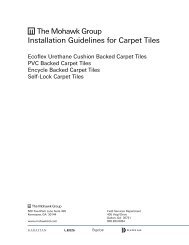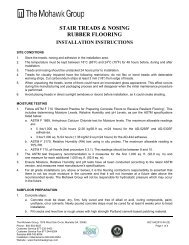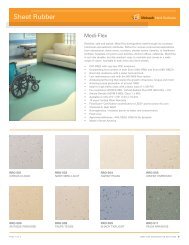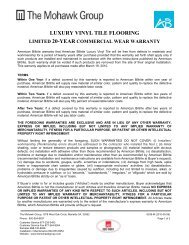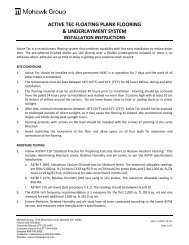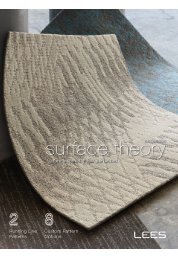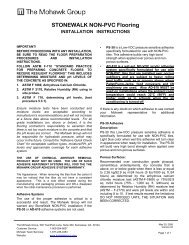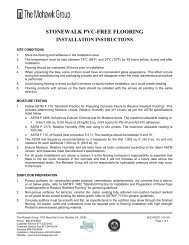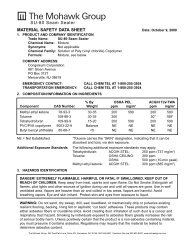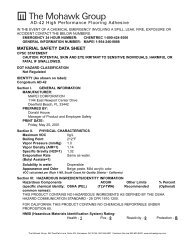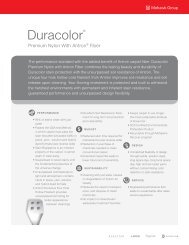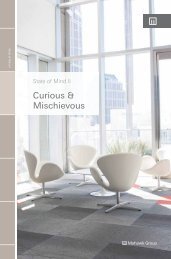Acoustic Management In Healthcare - Mohawk Group
Acoustic Management In Healthcare - Mohawk Group
Acoustic Management In Healthcare - Mohawk Group
You also want an ePaper? Increase the reach of your titles
YUMPU automatically turns print PDFs into web optimized ePapers that Google loves.
<strong>Acoustic</strong> <strong>Management</strong><br />
<strong>In</strong> <strong>Healthcare</strong><br />
August 2, 2009<br />
Keith Gray MS.<br />
Director of Technical Marketing, The <strong>Mohawk</strong> <strong>Group</strong>
Creating A Better<br />
Sound Environment<br />
Noted authority, Susan E. Maser, states<br />
that “When we think of places where we<br />
want to rest and recuperate from illness<br />
or medical treatment, most of us visualize<br />
places that are quiet, peaceful and serene.<br />
This is a stark contrast to the typical<br />
hospital, where sounds of beepers, alarms,<br />
machines, telephones, voices and more<br />
are part of the ‘normal’ environment.” She<br />
continues by saying, “The epidemic of noise<br />
in hospitals - one of the biggest complaints<br />
of patients - can no longer be ignored. “<br />
Audible sound may be defined as<br />
transmitted vibrations with frequencies in<br />
the range of 20 hz to 20,000 hz, capable of<br />
being detected by the human ear. But noise<br />
is a sound that is unpleasant, unexpected<br />
and undesired.<br />
The sources of noise in healthcare are<br />
many. They include equipment such as<br />
telephones, pagers, monitors and alarms,<br />
paging systems, wheeled equipment,<br />
IV poles, TV speakers, pneumatic tube<br />
systems, elevators and automatic doors.<br />
HVAC systems are the most common<br />
source of background noise, the human<br />
voice itself is also a major source.<br />
The effects of noise in healthcare<br />
settings are diverse, ranging from<br />
inpatient’s reporting unsatisfactory<br />
hospital experiences according to the<br />
Press Ganey exit surveys, through more<br />
serious consequences such as causing life<br />
threatening medication errors.<br />
The EPA recommended guideline values for<br />
background noise in hospitals is 45 decibels<br />
(dB) during the day and 35 dB at night. But<br />
these levels are voluntary and not enforced<br />
by law or by code, and are rarely met.<br />
Published studies have reported noise levels<br />
in excess of 95 dB in patient care areas,<br />
precisely where the advantages of good<br />
acoustic management are most needed.<br />
Patients in facilities with good acoustical<br />
management have better outcomes, heal<br />
more quickly and report a more satisfactory<br />
experience according to Press Ganey exit<br />
surveys.<br />
carpet absorbs<br />
between 15 – 25% of<br />
airborne noise<br />
Similarly, caregivers report enhanced<br />
performance in quieter environments<br />
reflected in fewer distractions, lower mental<br />
fatigue and less vocal strain. <strong>In</strong>vestigators<br />
further report 20-30% reductions in staff<br />
errors, preventing incalculable patient<br />
discomfort and saving facilities billions of<br />
dollars annually in avoided costs.<br />
So quieter is always better in the indoor<br />
healthcare environment, and as the<br />
consequences of the noise epidemic in<br />
healthcare – physical, emotional and<br />
financial – have become more widely<br />
understood, so has the role of carpet<br />
in creating a better sound environment<br />
become more appreciated by hospital<br />
administrators, patients, caregivers<br />
and the A&D community.<br />
Two tests are most often used to measure<br />
the acoustic performance of flooring in<br />
healthcare. ASTM C423 reports airborne<br />
noise reduction; and Noise Reduction
Coefficients (NRC) of interior surfaces and<br />
finishes. ASTM E90 reports the impact<br />
insulation classification (IIC) of surfaces,<br />
which manage noise transmission through<br />
building structures. By either test, carpet<br />
is an extraordinarily effective acoustic<br />
management tool.<br />
Errors of this type often result in lawsuits,<br />
and the average cost of an out-of-court<br />
settlement is $275,000. A similar benefit<br />
applies to patient outcomes, in general.<br />
More than any other surface, carpet<br />
effectively absorbs background noise,<br />
loud disturbing sounds such as monitors,<br />
Compared to hard surfaces typically found<br />
in healthcare, such as luxury vinyl tile,<br />
rubber flooring, engineered flooring and<br />
VCT, carpet absorbs between 15 – 25%<br />
of airborne noise, compared to only 0-5%<br />
for the hard surfaces mentioned. Perhaps<br />
more important, carpet is especially<br />
effective in absorbing those frequencies<br />
common to background noise, which<br />
dramatically improves speech recognition.<br />
This is important, for example, when<br />
transcribing a verbal order from a physician<br />
into a written order on a medical chart.<br />
alarms, paging systems and cell phones,<br />
and structure-borne noise. All of these<br />
are disturbing and undesirable. They<br />
interfere with rest, which interferes with<br />
recovery. Only carpet provides acoustic<br />
management which, combined with good<br />
noise reduction programs, creates an<br />
environment favorable to good patient<br />
outcomes.



